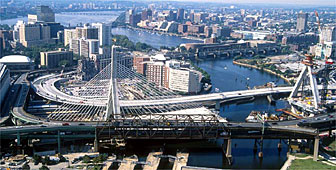Boston bridge links engineering with art

A Swiss-designed bridge in Boston is set to be more than a means of crossing the Charles River. It will also be a work of art.
Designer Christian Menn conceived the bridge as a symbolic landmark linking Boston’s future with its historic past. His intention was that it should reflect, with its inverted Y-shaped towers, the shape of the Bunker Hill monument in nearby Charlestown.
Scheduled for completion in 2004, it will be open to traffic before then as each stage of the project is finished. The bridge is 440 metres long and will eventually carry 10 lanes of traffic.
In engineering terms, the structure is breaking new ground. It will be the widest cable-stayed bridge in the world, and the first asymmetrical “hybrid” construction of its kind, using both steel and concrete in its frame.
But the bridge is expected to be equally stunning for aesthetic reasons. The two grey towers, 82 metres high, will anchor a fan of cables in order to evoke Boston’s maritime history. As they rise, each tower tapers to a pyramidal cap with a single red light.
Menn believes that the biggest visual thrill will come on the bridge itself, when northbound drivers see the approaching city unfold from behind the cables.
“Driving through the triangular arch of the towers will be like coming through a gateway, into the valley of the city,” he said. “It should be very striking.”
by Richard Dawson

In compliance with the JTI standards
More: SWI swissinfo.ch certified by the Journalism Trust Initiative







You can find an overview of ongoing debates with our journalists here . Please join us!
If you want to start a conversation about a topic raised in this article or want to report factual errors, email us at english@swissinfo.ch.